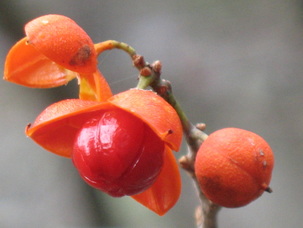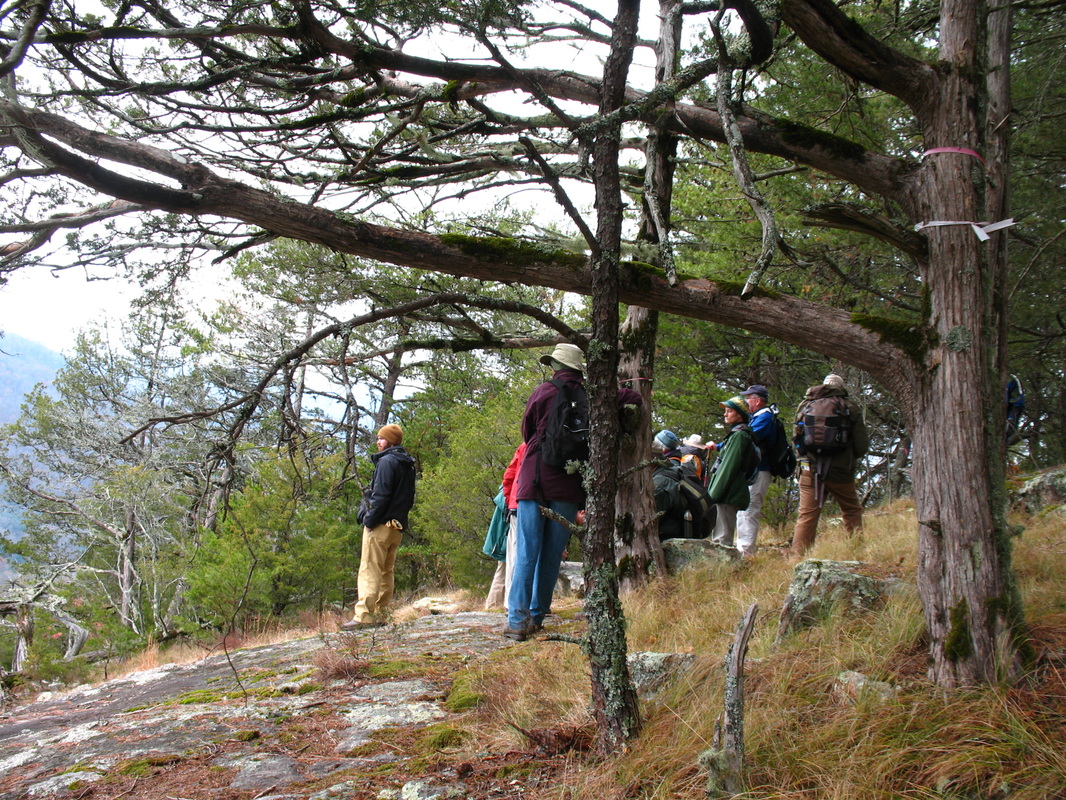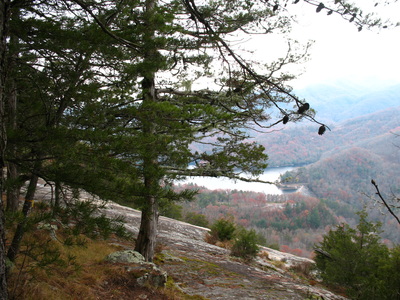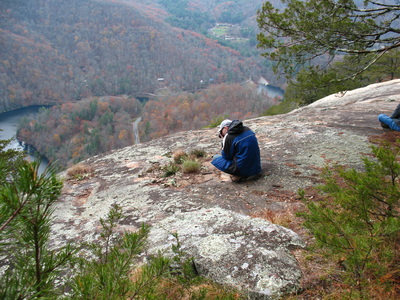Cedar Cliff
No trails, steep climbs, beautiful viewsThis preserve is, admittedly, not one that volunteer stewards seek out. The climb in is long and steep--not an easy place.
Once at the top, the view is nice, but if the rock is wet or icy, it is perilous. Visits to this preserve are few, and must be guided for reasons of safety. As on all preserves, there are no trails to follow. |
Protected plant species

Celastus scandens, American bittersweet, is found on this site. Unfortunately, this vine crosses easily with the far more common C. orbiculatus, Asian bittersweet, that is a serious pest in New England states.
In western NC, the Asian bittersweet has become such a pest that wildcrafters are discouraged from using the vine in arrangements. When they do and the arrangements are eventually discarded, the seeds find their way into dumps, compost piles, or tossed into fields for forests. The seeds germinate easily, birds consume them, and the plants spread.
How do you tell one from the other? - - -
Celastrus scandens flowers are in a terminal array of 6 or more flowers, leaf blades usually more than 2 times as long as wide, and capsules usually with 0 or 1 seeds
Celastrus orbiculatus flowers are in axillary arrays with 2 or 3 flowers, leaf blades usually less than 2 times as long as wide, and capsules usually with 5 or more seeds.
Silene ovata, mountain catchfly, a Special Concern-Vulnerable species, also grows in the area.
While hiking up the mountain, you might also see:
The Preserve protects Silene ovata, mountain catchfly, a North Carolina Special Concern-Vulnerable species, which should be in bloom, and Celastrus scandens, our Endangered American bittersweet, which should be in fruit. A few other species of interest on the Preserve are:
Entodon sullivantii, Sullivant's moss
Hackelia virginiana, beggars-lice
Hexalectris spicata, ccrested coral root
Macrocoma sullivantii, Sullivant's macrocoma moss
Mannia californica, a liverwort
Physica pseudospeciosa, a lichen
Scopelophila ligulata, copper moss
Sedum glaucophyllum, cliff stonecrop
Tortula ammonsiana, Ammon's tortula moss
Tortula fragilis, fragile tortula moss
Usnea angulata, beard lichen
and lots of others!
In western NC, the Asian bittersweet has become such a pest that wildcrafters are discouraged from using the vine in arrangements. When they do and the arrangements are eventually discarded, the seeds find their way into dumps, compost piles, or tossed into fields for forests. The seeds germinate easily, birds consume them, and the plants spread.
How do you tell one from the other? - - -
Celastrus scandens flowers are in a terminal array of 6 or more flowers, leaf blades usually more than 2 times as long as wide, and capsules usually with 0 or 1 seeds
Celastrus orbiculatus flowers are in axillary arrays with 2 or 3 flowers, leaf blades usually less than 2 times as long as wide, and capsules usually with 5 or more seeds.
Silene ovata, mountain catchfly, a Special Concern-Vulnerable species, also grows in the area.
While hiking up the mountain, you might also see:
The Preserve protects Silene ovata, mountain catchfly, a North Carolina Special Concern-Vulnerable species, which should be in bloom, and Celastrus scandens, our Endangered American bittersweet, which should be in fruit. A few other species of interest on the Preserve are:
Entodon sullivantii, Sullivant's moss
Hackelia virginiana, beggars-lice
Hexalectris spicata, ccrested coral root
Macrocoma sullivantii, Sullivant's macrocoma moss
Mannia californica, a liverwort
Physica pseudospeciosa, a lichen
Scopelophila ligulata, copper moss
Sedum glaucophyllum, cliff stonecrop
Tortula ammonsiana, Ammon's tortula moss
Tortula fragilis, fragile tortula moss
Usnea angulata, beard lichen
and lots of others!





